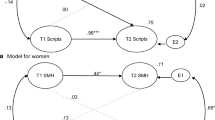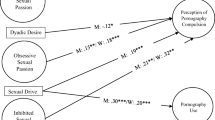Abstract
A survey of 458 early adolescents (87% White; 278 females and 280 males; Mage = 13) examined the interacting relationship between family environment and involvement with pop music, and attitudes toward sexual harassment, while also controlling for sex. Attitudes toward sexual harassment were assessed by an eight-item Likert-type scale constructed from common behavioral definitions of sexual harassment (reliability alpha = .89). Results indicated females held less accepting attitudes toward sexual harassment than males. Involvement with pop music was associated with acceptance of sexual harassment, especially for females. The combination of a high level of exposure to pop music videos, and being from an unsatisfactory or nonintact family, was strongly associated with acceptance of sexual harassment for females and less so for males. The findings of this study could have implications for the etiology of acceptance of other coercive behaviors among adults.
Similar content being viewed by others
References
AAUW. (1993).Hostile hallways. Washington, DC: American Association of University Women.
Abt, D. (1987). Music video: Impact of the visual dimension. In J. Lull (Ed.),Popular music and communication (pp. 96–111). Newbury Park, CA: Sage.
Ageton, S. S. (1983).Sexual assault among adolescents. Lexington, MA: Lexington Books.
Aufderheide, P. (1986). Music videos: The look of the sound.Journal of Communication, 36(1), 57–78.
Bischof, G. P., Stith, S. M., & Wilson, S. M. (1992). A comparison of family systems of adolescent sexual offenders and nonsexual offending delinquents.Family Relations, 41 318–323.
Brown, J. D., & Campbell, K. (1986). Race and gender in music videos: The same beat but a different drummer.Journal of Communication, Winter, 95–106.
Brown, J. D., Childers, K. W., Bauman, K. E., & Koch, G. G. (1990). The influence of new media and family structure on young adolescents' television and radio use.Communication Research, 17 65–82.
Buerkel-Rothfuss, N., & Strouse, J. S. (1993). Media exposure and perception of sexual behaviors: The cultivation hypothesis moves to the bedroom. In B. S. Greenberg, J. Brown, & N. Buerkel-Rothfuss (Eds.),Media, sex and the adolescent. Cresskill, NJ: Hampton Press.
Calfin, M. S., Carroll, J. L., & Shmidt, J. (1993). Viewing music-videotapes before taking a test of premarital sexual attitudes.Psychological Reports, 72 475–481.
Gerbner, G., Gross, L., Morgan, M., & Signorielli, N. (1986). Living with television: The dynamics of the cultivation process. In J. Bryant, & D. Zillmann (Eds.),Perspectives on media effects. Hillsdale, NJ: Lawrence Erlbaum.
Grauerholz, E., & Koralewski, M. A. (1991). What is known and not known about sexual coercion. In E. Grauerholz & M. A. Koralewski (Eds.),Sexual coercion: A sourcebook on its nature, causes, and prevention. Lexington, MA: Lexington Books.
Greeson, L. E., & Williams, R. A. (1986). Social implications of music videos for youth: An analysis of the content and effects of MTV.Youth and Society, 18 177–189.
Hansen, C. H., & Hansen, R. D. (1990). Rock music videos and antisocial behavior.Basic and Applied Social Psychology, 11 357–369.
Huston, A. C., et al. (1992).Big world, small screen: The role of television in American society. Lincoln: University of Nebraska Press.
King, P. (1988). Heavy metal music and drug abuse in adolescents.Postgraduate Medicine, 83 295–302.
Lintz, D. & Malamuth, M. (1993).Pornography. Newbury Park, CA: Sage.
Lott, B. (1993). Sexual harassment: Consequences and remedies.The NEA Higher Education Journal, VIII 89–103.
Lott, B., Reilly, M. E., & Howard, D. (1982). Sexual assault and harassment: A campus community case study.Signs, 8 296–319.
Manning, A. (1993, March 24). Schoolgirls sexually harassed.USA Today, p. 1D.
Monastersky, C., & Smith, W. (1985). Juvenile sexual offenders: A family systems paradigm. In E. M. Otey & G. D. Ryan (Eds.),Adolescent sex offenders: Issues in research and treatment (DHHS Publication No. ADM 85-1396, pp. 164–175). Rockville, MD: U.S. Dept. of Health and Human Services.
National Research Council. (1993).Losing generations: Adolescents in high-risk settings. Washington, DC: National Academy Press.
Pryor, J. B. (1987). Sexual harassment proclivities in men.Sex Roles, 17 269–290.
Puente, M. (1992, October 5). Year late, Hill has edge in ‘he said, she said’ saga.USA Today, p. 10A.
Reilly, M. E., Lott, B., Caldwel, D., & DeLuca, L. (1992). Tolerance for sexual harassment related to self-reported sexual victimization.Gender and Society, 6 122–138.
Roscoe, B., Strouse, J. S., & Goodwin, M. P. (in press). Sexual harassment: Early adolescents' self-reports of experiences and acceptance.Adolescence.
Rubin, R., Rubin, A., Perse, E., Armstrong, C., McHugh, M., & Faix, N. (1986). Media use and meaning of music video.Journalism Quarterly, 62 353–359.
Sherman, B. L., & Dominick, J. R. (1986). Violence and sex in music videos: TV and rock ‘n’ roll.Journal of Communication, Winter, 79–93.
Sommers-Flanagan, R., Sommers-Flanagan, J., & Davis, R. (1993). What's happening on music television? A gender role content analysis.Sex Roles: A Journal of Research, 28 745–753.
Stout, K. D. (1991). A continuum of male controls and violence against women: A teaching model.Journal of Social Work Education, 27 305–319.
Strauss, S. (1988). Sexual harassment in school: Legal implication for principles.NASSP Bulletin, 72 9, 37.
Strouse, J. S., & Buerkel-Rothfuss, N. (1987). Self reported media exposure and sexual attitudes and behaviors of college students.Journal of Sex Education and Therapy, 13 43–51.
Strouse, J. S., Buerkel-Rothfuss, N., & Long, E. C. (in press). Gender and family as moderators of the relationship between music video exposure and adolescent sexual permissiveness.Adolescence (accepted for publication).
Strouse, J. S., & Fabes, R. A. (1985). Formal vs. informal sources of sexuality education: Competing forces in the sexual socialization process.Adolescence, XX 251–263.
U.S. Merit Systems Protection Board. (1981).Sexual harassment in the workplace: Is it a problem? Washington, DC: U.S. Government Printing Office.
Wells, A. (1985, April).Gender, emotions and popular music. Paper presented at the meeting of the Midwest Sociological Society Annual meeting, St. Louis, MO.
Wright, R., & Anderson, V. (1989, November).The impact of electronic media on sexual attitudes of adolescents. Paper presented at the meeting of the National Council on Family Relations, New Orleans, LA.
Author information
Authors and Affiliations
Rights and permissions
About this article
Cite this article
Strouse, J.S., Goodwin, M.P. & Roscoe, B. Correlates of attitudes toward sexual harassment among early adolescents. Sex Roles 31, 559–577 (1994). https://doi.org/10.1007/BF01544280
Issue Date:
DOI: https://doi.org/10.1007/BF01544280




